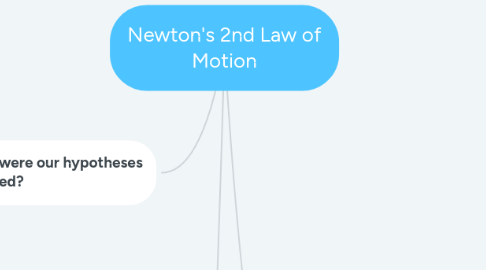
1. How were our hypotheses created?
1.1. Scientific Method
1.1.1. We didn't generate our own question (Step 1 of the scientific method) as this was provided to us as the topic of our lesson.
1.1.1.1. The scientific method can be applied to many disciplines as well as to non-scientific personal or social observations.
1.1.1.1.1. The scientific method could be used to understand why a friend seems to be sad a lot.
1.1.1.1.2. As this is a physics class, it makes sense that a physics observation is used, and since Netwon's 2nd Law of Motion is what we are supposed to be learning in this unit, it makes sense that is how we are applying the scientific method.
1.1.2. Nor did we do any research (Step 2 of the scientific method), as we were told us this topic is well understood, and this unit's primary goal is to apply the other steps of the scientific method to give us a deep understanding of Newton's second Law of motion.
1.1.3. We initially focused on constructing plausible models/hypotheses for the relationship between force, mass, and acceleration (Step 3 of the scientific method) using our prior knowledge and experience.
1.1.3.1. Math
1.1.3.1.1. We recalled how dependent variables are affected by independent variables (z=cx/y) with a constant c.
1.1.3.2. Physics
1.1.3.2.1. We recalled physics concepts/terms like force, net force, mass, acceleration, and velocity.
1.1.3.3. Experinece
1.1.3.3.1. We were given a thought experiment about hockey pucks of different sizes upon which we applied larger and smaller pushes (Forces) from which we created several plausible hypotheses using our prior knowledge and experience.
1.1.3.4. Hypotheses
1.1.3.4.1. While we were confident that larger forces on a given mass would create larger accelerations and larger masses for a given force would experience smaller accelerations than a smaller mass, we were unable to determine if there were some unknown coefficient in this relationship simply from the thought experiment (i.e. For a=cF/m we couldn't tell the value of c from the thought experiment, so we created several models).
2. What conclusions were made about Newton's Second Law of Motion and what does it mean?
2.1. Scientific method
2.1.1. We drew our conclusions which is the second part of Part 5 of the Scientific method).
2.1.1.1. When we refer to force we are, of course, referring to net force, since an object on the ground is being subject to a host of other forces such as gravity, the normal force of the ground, and the force from air pressure.
2.1.1.1.1. Only when there is an imbalance of these forces or net force, do we get an acceleration.
2.1.1.2. Classically, we did this experiment in a near inertial (or Galilean) frame reference, which is necessary. That is, a non-accelerating frame reference.
2.1.1.2.1. If the experiment were done in a non-inertial or accelerating frame reference like an elevator or in a truck speeding over a hilltop, we would not have achieved consistent results.
2.1.1.3. Newton's 2nd Law of motion has several consequences.
2.1.1.3.1. Using our thought experiment followed by our experiment, we found the following:
2.1.1.4. If we had not chosen the a=F/m model we would have still had good results.
2.1.1.4.1. The data would not have supported any of the models we had chosen and we would have revisited our hypotheses and developed one which better matched the data.
2.1.1.5. While a=F/m is a perfectly valid form of Newton's second law of motion, it is more commonly written:
2.1.1.5.1. F=ma or F=∆P/∆t
2.1.2. This mind map serves as a way to communicate our results (or at least part of the way) which is Step 6 of the scientific methods.
2.1.2.1. Using this mind map as a structure to write our paper would be more in line with Step 6.
3. How were our hypotheses tested and analyzed?
3.1. Scientific method
3.1.1. We tested our hypotheses (Step 4 of the scientific method) by recording the motion of an object (a ball bearing) of a known mass (0.0054 Kg) under a known force (0.053 N) from gravity.
3.1.1.1. We were given that the motion of an object, under constant acceleration with zero initial velocity and position, takes the form of d=(1/2)*a*t^2.
3.1.1.2. Experiment set up
3.1.1.2.1. Meter stick was hung vertically on a wall in a brightly lit region so the iPad would record a clear video.
3.1.1.2.2. The ball bearing was dropped from the zero position at the top of the meter stick, trying to impart zero initial velocity, multiple times.
3.1.1.2.3. The iPad was positioned and clamped so that it had a clear view of the meter stick.
3.1.2. We analyzed and read the data using iMovie (First Part of Step 5 of the scientific method) then entering in the cleanest data from from our experiment in to a spreadsheet and producing a graph comparing the data to the models.
3.1.2.1. Some of the data was problematic.
3.1.2.1.1. On inspection of the data using the iMovie edit mode (which allows frame by frame incrementing of the video (which was recorded at 120 fps)), at times the ball bearing had an initial starting velocity or started from a non-zero position.
3.1.2.2. Using the best data, we entered into our spreadsheet the displacements positions of the ball bearing as it fell, sometimes needing to interpolate.
3.1.2.2.1. Some of the markings on the meter stick were not clear enough to be readable, but the bigger numbers were clear.
3.1.2.3. We entered the time into our spreadsheet.
3.1.2.3.1. As we knew each frame was 1/120th of a second apart, we knew the time of each data measurement.
3.1.2.4. We entered our models into our spreadsheet.
3.1.2.4.1. Since we had a known mass and a known force, and our models all predicted a constant acceleration under those conditions, we applied the displacement equation of an object under constant acceleration
3.1.2.5. We produced a plot of our data and the three models.
3.1.2.5.1. Data
3.1.2.5.2. Models
3.1.2.5.3. Results
